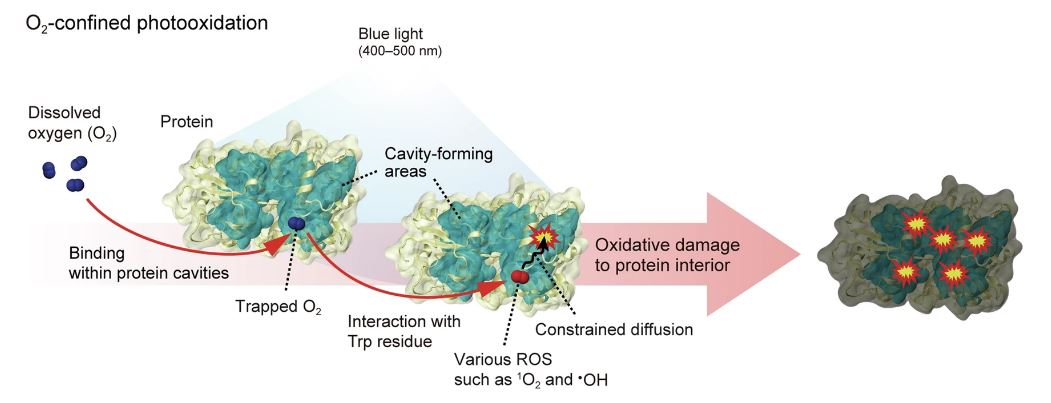Abstract
A research team, consisting of Professors Duyoung Min, Tae-Hyuk Kwon, and Seung Kyu Min from the Department of Chemistry at UNIST, announced that they have identified a novel pathway through which blue light can damage cellular proteins.
Blue light, which emanates from sunlight, LED-based display devices, and indoor lighting, is a form of high-energy visible light that is not effectively blocked by standard sunscreen. This type of light can penetrate the cornea and lens of the eye, reaching the retina.
Upon reaching the body, blue light is known to induce oxidative damage to cellular proteins, which can adversely affect skin and eye health. When dissolved oxygen in the body absorbs blue light, it is transformed into highly reactive oxygen species (ROS). This ROS can oxidize and damage the protein surface by infiltrating between proteins within cells. Fortunately, the intracellular antioxidant system can mitigate this protein damage by neutralizing ROS.

Figure 1. Proposed pathway of O2-confined photooxidation.
However, the protein damage pathway discovered by the research team occurs within protein cavities that are beyond the reach of the antioxidant system. In this mechanism, oxygen trapped in these cavities interacts with specific amino acids and absorbs blue light energy, converting it into ROS. The resulting ROS then diffuses through the protein cavity, ultimately leading to protein damage.
The research team conceptualized this pathway based on the structural properties of proteins. Proteins possess complex structures in which amino acid chains are intricately folded, creating numerous spaces that can capture small molecules. A variety of experiments, calculations, statistical analyses, and bioinformatics approaches were employed to substantiate their findings from multiple perspectives. This novel pathway of protein damage has been designated the "oxygen-defined photooxidation pathway."
Professor Min stated, "We have discovered a new protein damage pathway that is fundamentally different from the conventional mechanisms of protein damage, and we have demonstrated that it can universally affect proteins throughout the cell." He further explained, "This newly identified protein damage pathway may represent a hidden principle contributing to aging or disease processes in skin and eye tissues due to blue light exposure."
The research findings were published in the June 2024 issue of Nature Communications. The work was supported by the National Research Foundation of Korea (NRF) and UNIST.
Journal Reference
Seoyoon Kim, Eojin Kim, Mingyu Park, et al., "Hidden route of protein damage through oxygen-confined photooxidation," Nat. Comm., (2024).






